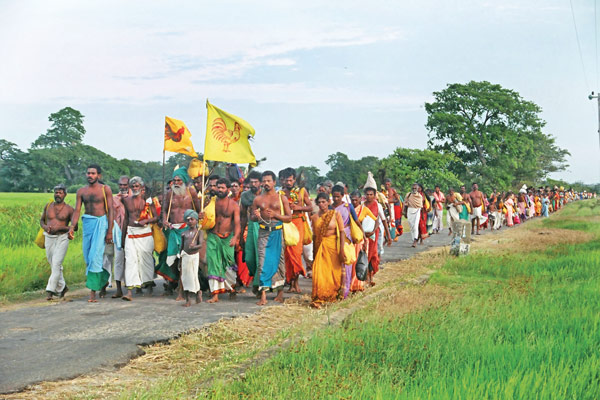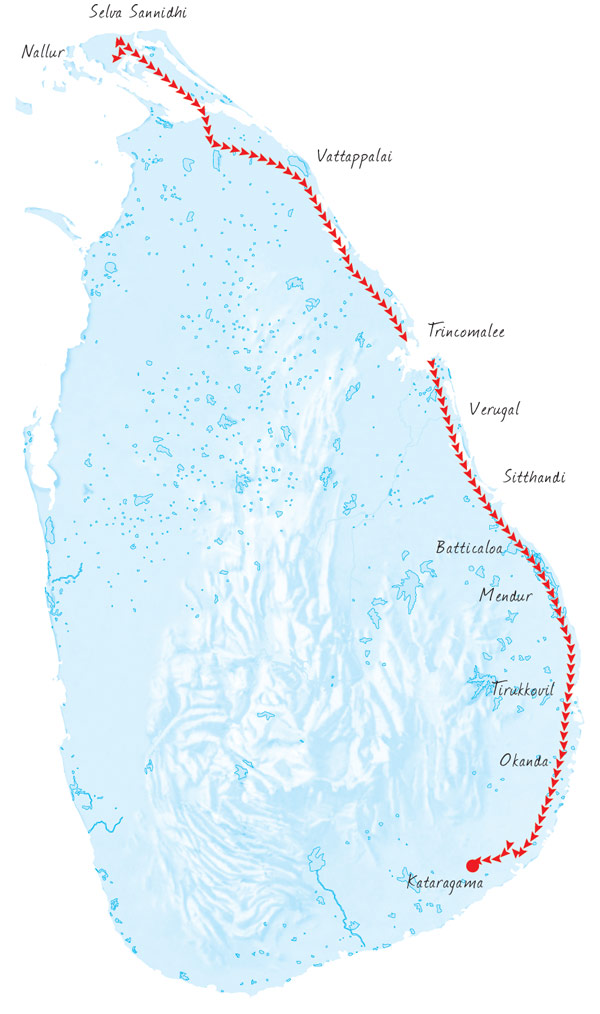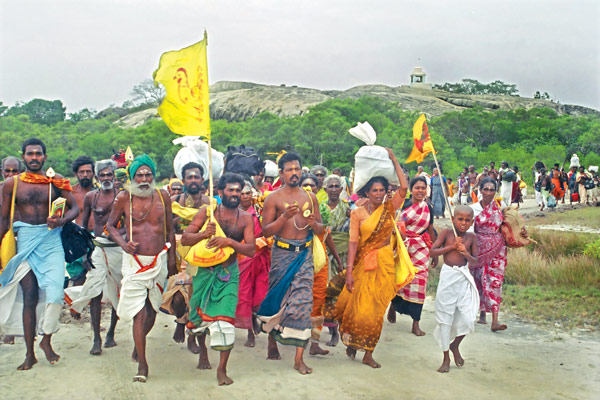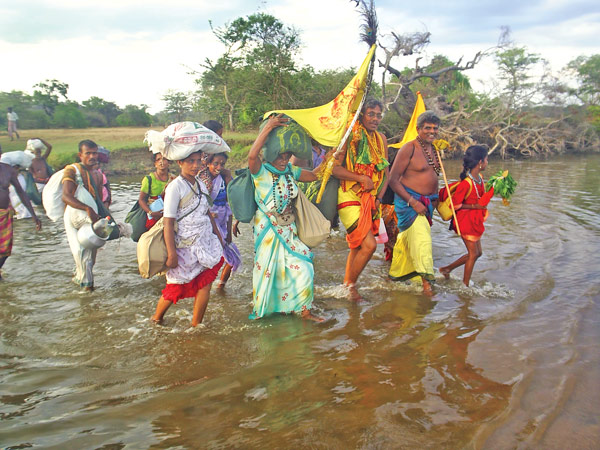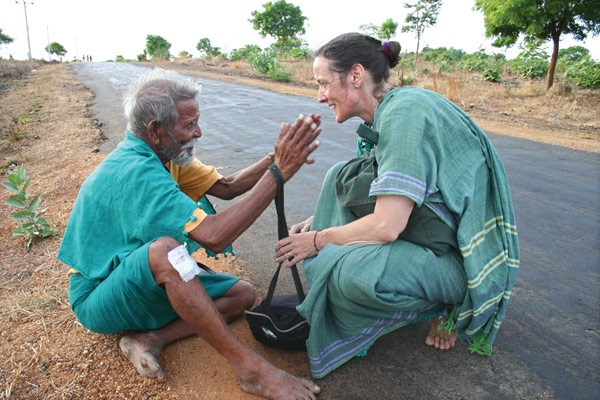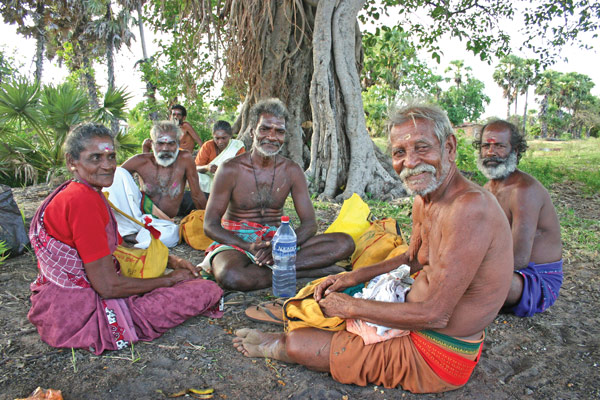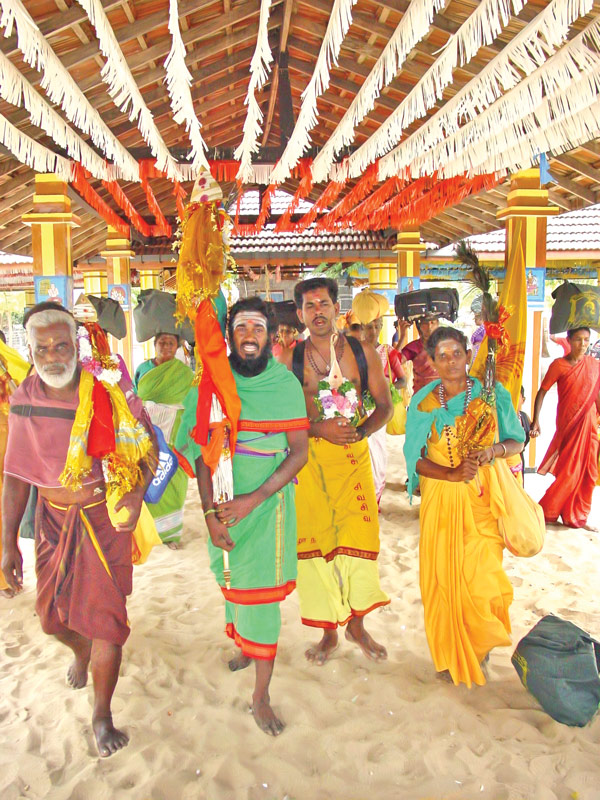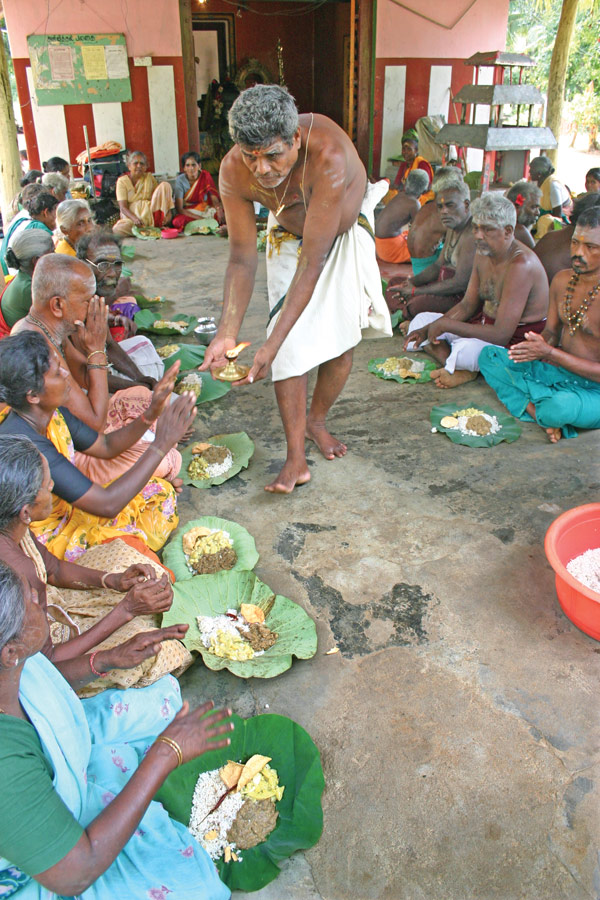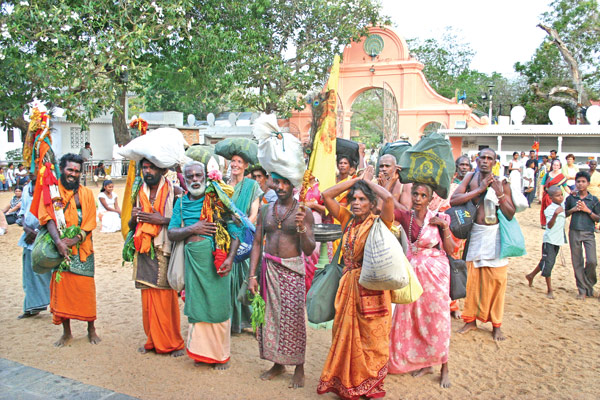
|
|
|
Pilgrimage and Mystical PracticeDr. T. SenthilverlPiligrims have journeyed to sacred places from ancient times. The reasons for pilgrimages are varied. Many devotees seek divine help at times of distress or want. They vow to undertake a pilgrimage once divine help is received. Such a pilgrimage is seen as an act of thanksgiving, showing gratitude and even devotion. They also consider they are carrying out their part of bargain with God. Some of these pilgrims perform penances, most of which appear to be spectacular feats of endurance such as angaprakadshina, kavadi or firewalking. Such practices, however, have various spiritually beneficial effects as well. Then there are those who desire to take a dip in holy waters wishing to wash away past sins and thereafter visit shrines and sages. Some pilgrims may seek divine guidance to the right path both in the material and spiritual worlds for themselves as well for their loved ones. Many a pilgrim's aim is to transfer the merit gained as a result of the pilgrimage to others including even ancestors. Performing penance could be another reason for a pilgrimage. Realization of the Self, raising of the Kundalini, tasting amirtam, various siddhis, divine visions are some experiences in the process. The majority who visit sacred places of worship today are satisfied with seeing the arathanai puja, having an archanai done or depositing cash into the strategically placed donation boxes. Indeed a pilgrimage need not be undertaken for just one reason. I would like to address the pilgrim on a thanksgiving pilgrimage before he returns home. "Your wish has materialized. So you are on this pilgrimage. Don't you ever wish to see Murugan, the great giver of boons, who fulfilled your request?" Quite often the answer would be, "Ah, that could happen only in the good old ages. Only in puranic times God appeared to man." If God could listen to you and give you just what you asked for, whether it be a request for a flourishing business, a vehicle, a wedding, a child, an estate, security or just good health certainly it would not be impossible for the omnipotent to appear in person. It is a very widespread practice to make vows and then go on pilgrimages. This practice is so popular because devotees have definitely asked for help and have benefited. However, one may have one's wishes fulfilled even without making vows. This fact is emphasized in the Tirumurais. A baby at feeding time does not make a vow to its mother. Bargaining with one's mother for milk is not necessary. The mother knows best and feeds the baby at the right times. If an ordinary mother may be so caring how much more kind would be our Holy Mother. Knowing when the baby is hungry, the mother gives what is good for the baby. If the baby asks for a sweet or an extra helping she obliges. But if the baby keeps on asking for more and more sweets, that is, too many sweets for its own good, she is reluctant to comply. However, if the child insists, she, though, reluctant, surely obliges. Consequently, the child suffers. Likewise, not knowing what suits us, we ask for many things, receive them and suffer the consequences. We often are like children asking for sweet things not knowing the right quantum or time. In the eigthth Tirumurai, the Tiruvasakam, Manickavasaka Nayanar addresses the almighty: Vendattakkatu arivoi nee
"Oh Almighty, you grant me everything that I request. But it is you who know what is best for me. What I desire is what you ordain for me," says the enlightened Manickavasaka Peruman. It is clear that it is not necessary to make vows. You ask and you get what you ask for whether you make a vow or not. But be careful. What you asked for may be a white elephant. What you wanted could be unwanted or cause undesirable consequences. What is worse is that whenever you ask for and get something it is on loan. If God keeps giving to those who ask would he not be unfair by the billions of his created beings who don't ask? Just as a banker would grant loans, God too grants boons. But remember that overdrafts must be paid back. If you borrow a hundred thousand rupees you are supposed to return a hundred thousand rupees. Would it not be wrong to re-pay a small percentage only? How could you justify asking God to grant you a 100,000 rupee profit and only deposit some coins in the temple donation box in return for his generous help? If you intend to repay, the payment should be equivalent to your borrowing. Otherwise I don't think it is a fair deal. God is not going to be very pleased either. God does not expect payment for what he gives unasked. God knows best what we need and when we need it and He, the Provider, will look after us. Then why worship at all? Why go on pilgrimages? At this point, I would like to focus on the mystical experiences of pilgrims. Murugan worship being prevalent from the remotest antiquity, naturally many apparent myths may mingle with true history. Let me give an example. Valli MalaiMany a temple on various hilltops has been dedicated to Valli, Murugan's consort. Devotees would have experienced many miracles, and Valli herself would have appeared to devotees and performed tiruvilayadals in these several places. It is not uncommon for a hill to be called Valli Malai if there is a Valli temple on it and if Valli has appeared there before devotees. That is, there are several hills in several places known as Valli Malai. Millenniua later it is also not uncommon for various writers to refer to each of these hills as that on which Valli grew up when being brought up by Nambirajan, the chief of the Vedars. It is not scholarly to dismiss the entire story of Valli just because many hills are called Valli Malai. Of course one malai would have been that of Nambirajan, on which Valli actually grew up. However, mystics would have seen Valli on all the different Valli Malais. I would like to repeat this. She may have grown up on only one hill but she has appeared on all the Valli Malais to devotees. I would like to state that the mystic visionary experience of devotees and pilgrims can give rise both to myths and to misunderstandings. I would like to suggest that a mystic visionary experience should be at the heart of all pilgrimages. I would now like to describe my personal experiences in this regard. SabarimalaiI have undertaken many pilgrimages and prefer to follow the time-tested traditional way in the matter. For instance there is the divine call, which begins it all. An example is a pilgrimage to Sabarimalai, the abode of Aiyappan in a thick and wild mountainous jungle. It is an arduous journey and preparing oneself for the journey is also arduous. However, the pilgrim is not the master of time and events,. The planning and the execution are in God's hands and the pilgrim surrenders his will to the will of God. The pilgrim says "Swamiye Saranam Iyappa" and therein lies the magic. When there is saranam, or total surrender, the pilgrimage becomes the responsibility of Aiyappan. What can he do but come over and play with and protect His devotee? Every Sabarimalai pilgrim is supposed to have guruswami. A guruswami is one who has had mystical experiences and who could dispel and doubts in the minds of an initiate and guide him to reach the summit of Sabarimalai. Even the guruswami surrenders to a guru, the guru of gurus; in other words Aiyappa. A parallel is seen in the 51st verse of Kantaranuputi by Arunagirinatha Swami. Uruvaai aruvaai ulataai ilataai
Arunagirnatha guruswami is asking that Murugan act as his guru. Arunagirinatha is no ordinary man. The words of another great guruswami, Tayumaanaswami, are an eloquent testimony. "Kantar anupooti petruk Kantar anupooti sonna entairaul naadiyirukkunaal ennaalo." A new pilgrim invokes the guidance of the guruswami who ceremoniously places a rudratchcha or tulasi mala around the neck of the initiate. The first timer is known as kanniswami, meaning a virgin pilgrim. The kanniswami adheres to certain observances during a mandalakalam, say a period of 48 days, prior to proceeding on the pilgrimage to the summit of the sacred mountain. He, like other Sabarimalai pilgrims, does not enjoy the comfort of a mattress but sleeps on a hard surface, usually on the ground over a mat, carpet or sheet and without a pillow. This would prepare the initiate for the arduous jungle journey. Sleeping on a hard flat surface also helps to attain a posture conducive to raising the Kundalini. In preparing for the pilgrimage, all devotees adhere to a strict vegetarian diet and refrain from taking any intoxicant. The devotee should be chaste in body and mind. In other words, even unchaste thoughts are taboo. Moreover, even unchaste dreams will make a devotee unfit for the pilgrimage. Marriage and procreation are natural and desirable. However, the energy and chemicals of the body are conserved for 48 days to attain states conductive to the production of substances such as amirtam and sironmani. The aim of the devotee is not to suppress desire but to attain a state of absolute non-desire. The pilgrim does not plan when he will return from the pilgrimage. Indeed he does not make plans but leaves everything to Aiyappan. All kanniswamis to Sabarimalai should be prepared to transfer all merit acquired during the pilgrimage to his parents and other ancestors. We are all indebted to our parents and other ancestors and repay out debts to them by doing this. Our parents nature us lovingly when we are helpless babies. God gives us a chance to repay them when they become old and, during their second childhood, are as helpless as babies. Unfortunately some of us are denied the chance to look after old parents by circumstances. So we repay them by transferring merit acquired during a pilgrimage to them. Our debts incurred in infancy and childhood increase with time just as interest accrues on loans. Fortunately God gives many of us the opportunity to care for two sets of old parents - one's own and those of one's spouse. Moreover, all our forefathers may not have attained mukti. Some may be suffering on a lower plane unable to attain a higher plane. We could alleviate their suffering by transferring some of the merit we acquire just as we deposit cash into the bank account of another person. To do the latter we need to know the account number of the other person. To do the former me need to know who our forefathers are and the tithi, month and year of their deaths. It is for this reason that the practice of kalvettu arose. In every household there was a stone pillar on which was engraved the names, tithi, month and year of death of ancestors. The tradition is still in vogue among the Tamils of Sri Lanka, albeit in a modified manner. Whenever a person passes away a booklet is published with these and other details. It is customary for a person to know the names and details of at least seven talaimurais. God is pleased with the devotee who transfers merit to his ancestors. God will appear to such a devotee. When the devotee takes one step in the pilgrimage God will take ten steps towards the devotee. There are those who think that we repay our parents by caring for our own children. We cannot rob Peter to pay Paul. What we do for our children is our duty. What we owe our parents is a debt. A devotee goes on a pilgrimage with bare necessities only. A guruswami is not responsible for the pilgrims he helps and guides. Aiyappan only is responsible. The guruswami has surrendered himself to Aiyappan and is not responsible even for his own self. How can he be responsible for others? If a pilgrim is lost in the large crowd of pilgrims at Sabarimalai the guruswami does not search for him. How is the lost pilgrim found? God takes the form of the guruswami and guides the pilgrim to the human guruswami and then God disappears to avoid the problem of there being two guruswamis. The glorious from of God is too glorious and awe-inspiring for ordinary mortals to behold and so God takes human form to help us. When ordinary human beings attain the fitness to behold God in the guise of a pilgrim. The worship is accepted as an act due to God and not to a mere pilgrim by the pilgrim who is worshipped. Aiyappan partakes of the food cooked by the pilgrims on the wayside during the pilgrimage. Avar ivar ennaatu anaivarkkum idumin is mantra. At an annadaanam one should serve food to everyone and not confine serving to selected or known people for one may miss a golden opportunity of feeding God who might have come in disguise. The ashes in the fireplace used to cook the food of which God has partaken will be full of sakti and is used as holy ash. Rubbing this ash on the body can relieve unbearable pain instantly. I reiterate that God appears before us during a pilgrimage. KataragamaLet me now speak of a pilgrimage to Katirkamam, an abode of Murugan. There was a time when pilgrimages to Katirkamam and other sacred places were also arduous. Today modern conveyances and conveniences have made these sites easily accessible. This ease has encouraged pilgrims to make their own plans whereas an arduous journey would have inspired awe and left all plans in the hands of God. I undertook a pilgrimage to Katirkamam in July 1989 at a time when there was unrest throughout the country. It is my custom to take lotus flowers and garlands and shower lotus petals on Murugan during the procession when he comes on an elephant to Valli's temple on the first and last days of the Adi festival. On the last day of the festival that year, grave premonitions were felt by many. After a bath in the Manika Ganga we awaited permission from Pillayar at Sella Katirkamam to leave for Katirkamam, but permission was not granted until dusk. Finally I was allowed to proceed to Katirkamam but could not decorate with flowers, as is my custom, the doorway by which Murugan enters to meet Valli. Neither could I decorate the particular doorway by which devotees enter the Teyvayanai Amman Temple once a year. At the Pillayar Temple in Katirkamam itself there is a preparatory puja before the procession commences. As usual I handed over a big garland to be placed over the Rahasiya Pelai. The chief priest completed the Gaja puja and Raja puja and gave the signal for the elephant bearing the pelai to start moving. The elephant would not move. The mahout could neither persuade nor force the elephant to move. He was shamefaced and the kapuralas looked on in disbelief. In an unprecedented way, the elephant drew the flames of the Panjaalaatti towards itself with its trunk. After what seemed like half an hour it reluctantly started the procession. I started showering lotus petals on Murugan. We were near the gateway leading to Curan Kottai. Suddenly I was assailed by doubts. Should I go into Curan Kottai? Would it not be theettu (taboo) to go there? Perhaps it would be all right. After all, if Murugan would enter Curan Kottai then so I could go, too. As I put a foot forward someone from behind pulled me back with great force. He told me that I had been asked to come to the Teyvayanai Amman Temple. I thought I was being summoned because that is the only day devotees are permitted to enter the sanctum beyond the tirai (curtain). I stopped showering petals and obeyed promptly. I was surprised to find no one except a bearded old man before the closed front doors of the temple. He pulled one door ajar, signalled to me to enter , and, when I entered, locked me in. I was alone in the dark facing the curtain before Teyvayanai Amman. I stood still and time seemed to stand still. I calmly accepted what had happened and thought there must be some purpose behind the occurrence. Then the chief priest look-alike entered the temple, signalled to me to go further in, and he commenced the inner sanctum puja. I heard noises of explosion outside and thought some devotees were lighting crackers. I even heard sounds that seemed like the sound of rolling seawaves and also singing. I was offered prasadam by the priest and it seemed rare and tasted extremely delicious. Later I learnt that bombs had exploded in front of the leading elephant on the road to Curan Kottai. The kapurala had fallen off the elephant; so had the mahout. A few of the alaatti ammas had died and so had a few others. Many (57 total) were injured. Pandemonium reigned outside. Had I continued to shower lotus petals I would have been between the elephant and the alaatti ammas and would have met with certain death. Who but He could have locked me in the Teyvayanai Amman Temple? What was it but His nadagam (play)? The other devotees who companied to me about this pilgrimage then rushed to the scene and looked for me among the dead and the bleeding. The elephant calmly completed the procession, despite the disturbance, came back to the Murugan temple and stood motionless for more than two hours. No one else was present during that time so I had the great and rare privilege and honour of standing in the courtyard of the Murugan temple with the elephant, which was still bearing the rahasiya pelai . Ulakam Yaavaiyum Taam Ulavaakkalum
Katirkamam is about 285 km from Colombo where I reside. Every year when flowers are loaded into a vehicle to be taken during a pilgrimage, a light drizzle falls on the flowers. The flowers are still fresh when we reach Katirkamam. However, it is amazing that the curry and rice transported in a light aluminium pan in the same vehicle is sizzling hot when I distribute the prasadam after the long journey of at least 12 to 13 hours with numerous stops and pujas at the temples on the way. Numerous are His tiruvilayattus. He eagerly awaits the pilgrims so He can play His nadagams. God reveals Himself to those who undertake a pilgrimage with awe and faith. Dr. T. Senthilwerl is a prominent Sri Lankan Tamil businessman and Murukan devotee. He is Trustee of five Murukan temples in Colombo. Dr T. Senthilwerl See also "Kanta Shasti Vratam" by the author.Research articles from Conferences on Skanda-Murukan |
